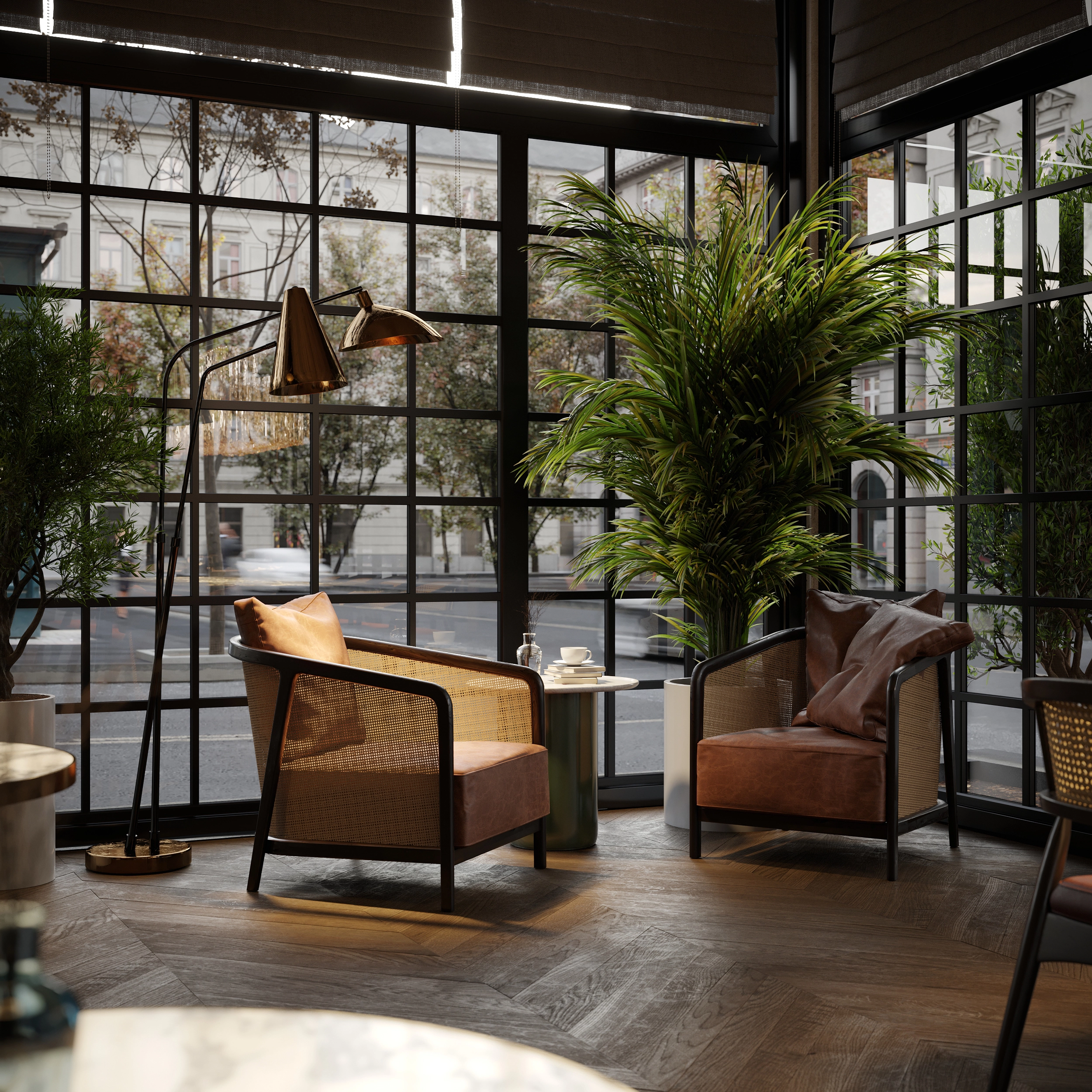Attracting commercial clients is known to be quite a challenging task. These clients have lofty expectations and are investing significant funds, which necessitates builders and designers to prove their service’s worth, not just to a single individual but to numerous stakeholders with vested interests.
In this article, we delve deep into all the crucial aspects of photorealistic 3D rendering in commercial projects.
Understanding Commercial Rendering
Commercial rendering refers to the practice of creating digital, visually impactful representations of commercial projects. These virtual models offer a realistic and detailed preview of a proposed commercial building, presenting every element from structural design to interior decor. Such renderings serve as a powerful communication tool between builders, designers, and commercial clients, helping to visually articulate ideas and potential modifications before actual construction begins.
Rendering can take multiple forms, namely 2D, 3D, and photorealistic high-definition, each having their unique applications and advantages.
In 2D renderings, a flat representation of the commercial building is created, often used for basic drafts or floor plans. However, to fully capture the intricacies of a commercial project, designers often employ types of 3D modeling.
3D Modeling allows for more detailed and spatially accurate renderings, offering a better sense of depth and scale, which is critical for commercial architectural rendering services. It employs several 3D modeling terms and techniques, such as surface, solid, or wireframe modeling, to create various elements of a building design.
Types of Commercial Renderings
Exterior renderings
3D Exterior renderings, an integral part of commercial projects, present a detailed representation of a building’s facade. With the help of this kind of 3D rendering, a business client can effectively visualize the future appeal of their potential structure.
An office building rendering, for instance, allows clients to envisage the height, exterior surface materials, windows, doors, and even the roofing. Beyond showcasing just the facade, exterior renderings also need to illustrate other key elements. These can include outdoor pathways, parking spaces, signs, and other features critical to the client’s site plans.
As a different example, 3D residential rendering can serve a similar purpose for real estate projects. Whether for commercial properties or real estate renderings, exterior renderings offer realistic portrayals that provide a comprehensive picture of a project before construction begins. This approach allows the concept to come to life, facilitating better communication and alignment between builders and clients.
Interior Renderings
3D Interior renderings are a significant aspect of commercial projects, providing a comprehensive view of the indoor spaces within business centers. Their primary purpose is to create high-quality images that offer potential buyers a glimpse into the building’s functionality and potential layout, facilitating their decision-making process.
Unlike simply showcasing walls, windows, or restrooms, comprehensive commercial rendering services dig deeper to illustrate the range of possibilities within the space. For instance, render resolution, an essential aspect of rendering, is crucial to creating high-quality images that accurately represent the potential of the space.
By incorporating interior decor, specifying colors, and detailing surface materials, interior renderings present a realistic view of the building’s potential. They go beyond just presenting the space, providing an architectural visualization that serves as a form of virtual reality for potential clients.
Aerial Renderings
In commercial real estate, giving potential buyers a bird’s eye view of a prospective property is often a vital part of the decision-making process. Aerial renderings, utilizing advanced CGI rendering techniques, provide this comprehensive perspective, which can make or break a multimillion-dollar commercial building project.
More than just giving an insight into the site’s scale and how the building will interact with its surrounding environment, aerial renderings offer a unique viewpoint of the roof design, which is often overlooked in typical floor plans. The strategic use of camera angles in these renderings can enhance the curb appeal of the project, giving potential buyers an all-encompassing perspective that standard renderings might not offer.
Landscape Renderings
In the realm of commercial building projects, landscape renderings often bring into focus the external spaces surrounding a commercial structure. Although this might seem like a minor detail when compared to the actual cost and functionality of the proposed building, it is of significant concern to commercial clients.
These types of renderings use advanced 3D visualization techniques to paint a picture of what the environment around the building will look like. They allow clients to view a detailed and realistic representation of the external features and aesthetics of the site, ensuring the high-end appearance of the commercial project.
Real Estate Renderings
In the realm of commercial real estate transactions, impressing your clients is paramount. Clients, whether they’re investing in a new property or considering a new office location, need assurance that their investment will attract commercial tenants. This is where real estate renderings become invaluable.
Real estate renderings provide a powerful visual aid, demonstrating the potential vibrancy and utility of a property. For instance, if you’re vying for a contract to develop a shopping center, create a dynamic representation that brings empty storefronts to life. Illustrate how the space would appear when bustling with customers and fully leased out.
Who Benefits from Commercial Renderings?
- Commercial Builders
Commercial builders can leverage renderings to depict the design and layout of the building before construction begins. This can help clients visualize the final product, making it an effective tool for securing contracts.
- Commercial Interior Designers
For interior designers, commercial renderings offer an opportunity to showcase potential interior layouts, decor, and overall aesthetics. This can be instrumental in client decision-making, as it brings design concepts to life.
- Commercial Landscapers
For landscapers, realistic renderings provide a clear representation of the proposed outdoor spaces, including plant arrangements, pathways, and recreational areas. This visual aid can significantly enhance client engagement and satisfaction.
Benefits of Commercial Renderings
-
Commercial renderings make it easier for clients to see their projects
As an accomplished commercial builder or designer, there may be times when words fall short in painting the exact picture of your vision. Even if you’re exceptional in articulating your plans, it could still be challenging for your commercial clients to accurately visualize the proposed outcomes of their buildings. This is where commercial renderings come into play. Expert 3D artists can create detailed 3D commercial renderings that allow clients to see exactly what their commercial building will look like, transforming your concepts into tangible and understandable visuals.
-
Commercial renderings foster better cooperation
Dealing with engaged business clients can be challenging when it comes to getting constructive feedback. Yet, to excel in serving your client, that synergistic energy is vital. Offering them a visual representation of the project can stimulate this collaboration.
By adopting this approach, you present your clients with appealing 3D renderings to review, instead of expecting them to decipher a textual description or sift through 2D construction blueprints. Not only does it captivate them, but it also gives them tangible references when they want to provide suggestions or feedback. Enhanced collaboration translates into increased project success.
-
Commercial renderings enhance marketing efforts
No commercial client is prepared to invest a significant sum unless they’re entirely assured of your competency to deliver the project. This is another immense advantage of commercial renderings: they serve as a portfolio of your work.
Rather than requesting clients to visit a building you’ve designed or simply trust your word, you’re providing them with a detailed, precise 3D visualization of a job you’ve already executed. In essence, using 3D rendering in real estate marketing is solid proof of your capabilities. 3D visualization benefits interior designers as well, showcasing their designs effectively to potential clients.
-
Commercial renderings hold the potential to significantly elevate sales prices
These high-quality architectural renderings not only authenticate your prowess in the field but also provide a visual aid for clients to present to their colleagues, investors, and clients. The unique features of your work, brilliantly illustrated through renderings, serve to impress investors. Consequently, if you provide this service while your competitors don’t, you can demand higher rates for your projects.
-
Commercial renderings can boost the rate of client conversions
Undeniably, images hold immense selling power, and fundamentally, commercial building renderings are compelling visuals. With exquisite 3D commercial renderings created by skilled 3D artists, you transcend beyond being a mere written profile or an anonymous entity. You become a proficient building or design professional who can manifest their expertise. This visual demonstration can boost conversion rates, leading to an increase in sales. In other words, when potential clients see what their project could look like, they are more likely to commit.
Conclusion
The benefits of commercial renderings are numerous, providing a significant advantage to builders and designers in marketing their skills and boosting conversions. To maximize these benefits, choosing a proficient 3D rendering company is crucial. In another stride, creating a design studio portfolio filled with stunning 3D interior renders can powerfully demonstrate your capability and further attract potential clients.
Consider Fortes Vision for top-notch 3D visualization services.














